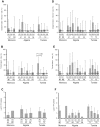Culex pipiens, an experimental efficient vector of West Nile and Rift Valley fever viruses in the Maghreb region
- PMID: 22693557
- PMCID: PMC3365064
- DOI: 10.1371/journal.pone.0036757
Culex pipiens, an experimental efficient vector of West Nile and Rift Valley fever viruses in the Maghreb region
Abstract
West Nile fever (WNF) and Rift Valley fever (RVF) are emerging diseases causing epidemics outside their natural range of distribution. West Nile virus (WNV) circulates widely and harmlessly in the old world among birds as amplifying hosts, and horses and humans as accidental dead-end hosts. Rift Valley fever virus (RVFV) re-emerges periodically in Africa causing massive outbreaks. In the Maghreb, eco-climatic and entomologic conditions are favourable for WNV and RVFV emergence. Both viruses are transmitted by mosquitoes belonging to the Culex pipiens complex. We evaluated the ability of different populations of Cx. pipiens from North Africa to transmit WNV and the avirulent RVFV Clone 13 strain. Mosquitoes collected in Algeria, Morocco, and Tunisia during the summer 2010 were experimentally infected with WNV and RVFV Clone 13 strain at titers of 10(7.8) and 10(8.5) plaque forming units/mL, respectively. Disseminated infection and transmission rates were estimated 14-21 days following the exposure to the infectious blood-meal. We show that 14 days after exposure to WNV, all mosquito st developed a high disseminated infection and were able to excrete infectious saliva. However, only 69.2% of mosquito strains developed a disseminated infection with RVFV Clone 13 strain, and among them, 77.8% were able to deliver virus through saliva. Thus, Cx. pipiens from the Maghreb are efficient experimental vectors to transmit WNV and to a lesser extent, RVFV Clone 13 strain. The epidemiologic importance of our findings should be considered in the light of other parameters related to mosquito ecology and biology.
Conflict of interest statement
Figures




References
-
- Smithburn KC, Hughes TP, Burke AW, Paul JH. A neurotropic virus isolated from the blood of a native of Uganda. Am J Trop Med Hyg. 1940;20:471–492.
-
- Kramer LD, Styer LM, Ebel GD. A global perspective on the epidemiology of West Nile virus. Annu Rev Entomol. 2008;53:61–81. - PubMed
-
- Le Guenno B, Bougermouh A, Azzam T, Bouakaz R. West Nile: a deadly virus? Lancet. 1996;348:1315. - PubMed
-
- Triki H, Murri S, Le Guenno B, Bahri O, Hili K, et al. West Nile viral meningo-encephalitis in Tunisia. Méd Trop. 2001;61:487–490. - PubMed
Publication types
MeSH terms
LinkOut - more resources
Full Text Sources
Medical

